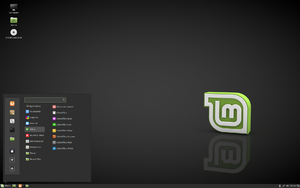Linux Mint
 |
|
 Linux Mint 18 Sarah Cinnamon edition 
Linux Mint 18 Sarah MATE edition
|
|
| Developer | Clement Lefebvre, Jamie Boo Birse, Kendall Weaver, and community |
|---|---|
| OS family | Unix-like |
| Working state | Current |
| Source model | Open source |
| Initial release | 27 August 2006 |
| Latest release | Linux Mint 18.1 "Serena" / 16 December 2016 |
| Available in | Multilingual |
| Update method | APT (+ mintUpdate, Synaptic) |
| Package manager | dpkg |
| Platforms | IA-32, x86-64 |
| Kernel type | Monolithic (Linux) |
| Userland | GNU |
| Default user interface | 1.0: KDE 3 2.0-11: GNOME 2 (KDE / Xfce / Fluxbox / LXDE for some versions) 12: GNOME 3 with MGSE 13-: Cinnamon / MATE / KDE 4 / Xfce |
| License | Mainly GPL and other free software licenses, minor additions of proprietary software |
| Official website | www |
Linux Mint is a community-driven Linux distribution based on Debian and Ubuntu that strives to be a "modern, elegant and comfortable operating system which is both powerful and easy to use." Linux Mint provides full out-of-the-box multimedia support by including some proprietary software and comes bundled with a variety of free and open-source applications; however, with the release of v18 "Sarah" some previously included proprietary software such as multimedia codecs was no longer included by default. Its motto is "from freedom came elegance."
The project was conceived by Clement Lefebvre and is being actively developed by the Linux Mint Team and community.
Linux Mint started in 2006 with a beta release of Linux Mint 1.0, code-named "Ada", based on Kubuntu. Following its release, Linux Mint 2.0 "Barbara" was the first version to use Ubuntu as its codebase. Linux Mint had few users from these early versions until the release of Linux Mint 3.0, "Cassandra."
Linux Mint 2.0 was based on Ubuntu 6.10, using its package repositories and using it as a codebase. From there, Linux Mint followed its own codebase, building each release from its previous one, but continued to use the package repositories from the latest Ubuntu release. This resulted in making the base between the two systems almost identical, guaranteeing full compatibility between the two distributions rather than having Mint become a fork.
In 2008, Linux Mint adopted the same release cycle as Ubuntu and dropped its minor version number before releasing version 5 "Elyssa." The same year, in an effort to increase the compatibility between the two systems, Linux Mint decided to abandon its code-base and changed the way it built its releases. Starting with Linux Mint 6 "Felicia," each release was now completely based on the latest Ubuntu release, built directly from it, and timed for approximately one month after the corresponding Ubuntu release, usually in May or November.
...
Wikipedia
